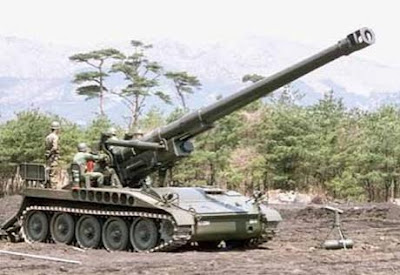The M110 howitzer was a self-propelled, 203-mm (8 in) artillery piece which was used by the US Army during the Vietnam War. It had been introduced into service in 1963 as the M110, from which two variants would be built; the M110A1 and M110A2. These had longer barrels. It was also fielded by the IDF in the 1982 Lebanese War and by Iran Army in the Iraq-Iran War in the 1980s.
The M110 howitzer was developed from the M115 towed gun, which was mounted on the chassis of the M107 self-propelled gun. This vehicle had torsion-bar suspension system. It was equipped with a bulldozer-type blade mounted at the back; it was driven into the ground to brake the recoil rearward movement at each shot. It was powered by a Detroit Diesel 8V71T, 8-cylinder, two-stroke diesel engine, which produced 405 HP. The gun was fitted with an automatic loader and fired high explosive shells to a maximum range of 23 km.
Aside from providing fire support to front-line troops and bombing casemates and bunkers, the M110 howitzer was also employed as counterbattery artillery. To take advantage of its long range capacity, it needed a manned observation post near the enemy target to be attacked to direct the fire. To load the breech, it had a hydraulic rammer that pushed the
Specifications
Type: self-propelled howitzer
Caliber: 203mm (8 inches)
Weight: 28.3 metric tons
Length: 10.8 m (35 feet, 5 inches)
Breech Type: interrupted screw
Elevation: +4 to +65 degrees
Traverse: +60 degrees
Muzzle Velocity: 590 m/s (1,930 ft/2)
Maximum Range: 16,800 m
Below, the M110A1 variant in Vietnam in 1971.
The M110A2 version, with muzzle brake, in 1979.
The M110 self-propelled howitzer (video).





No comments